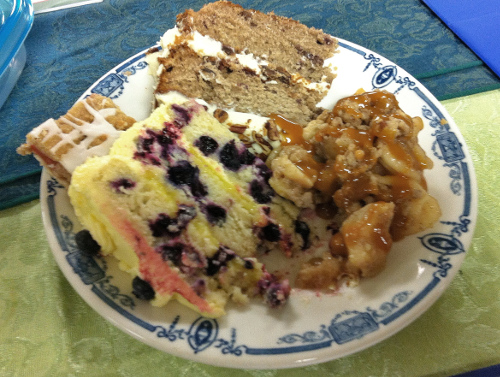10 Things I Learned from Judging a Recipe Contest
What do you do when you’re asked to judge a recipe contest? Say yes. That’s what I did when a staffer at the Parkersburg News & Sentinel inquired if I was available to help out with their 61st Annual Cookbook Contest. I’m always up to do something new, so I figured, why not?
The News & Sentinel’s cookbook contest is a bit of a misnomer, since it’s not a contest for cookbooks. Every year the paper puts out a call for recipes and publishes the finalists in a special insert of the paper (the “cookbook” in question). Having only moved here to the Mid-Ohio Valley a few years ago, I was curious to experience a behind-the-scenes peek at this local tradition, as well as sample what average newspaper readers in this region—which, despite its loveliness, is not known for adventurous culinary habits—cook at home. As the kind of person who considers radish greens a delicacy and nutritional yeast a pantry staple, I am often woefully out of touch with what non-crazy people eat, and I always need a reminder.
Another reason I said yes is because newspapers have a massively dwindled influence as the go-to source for new recipes. Only a few decades ago, many home cooks looked to their local paper’s weekly food section for inspiration via recipe request and readers’ exchange columns; it’s what kept your grandmother’s recipe file stocked with fresh clippings. We all share recipes in many other ways now, such as blogs and user-generated sites like Cooks.com or Allrecipes.com. It’s worth noting that reader entries for the News & Sentinel cookbook contest have dropped every year, despite the $500 grocery store gift card grand prize (hmm, maybe I should take a shot in 2016). Even so, there were 346 recipes entered this year, whittled down to the top 5 finalists per category.
Those finalists prepared the recipe they entered and dropped it off for the tasting party, where we judges scored entries on taste, preparation, originality, and overall appeal. It was fun and I meet some cool new people and got an ego boost as a local Food Media Professional of note. I also learned a few useful things about recipe contests and what happens when you literally pick food apart.
Look before you eat.
Not all delicious food looks wonderful, but presentation does count. Also, before taking a bite of anything, I’d first cut my portion in half and examine a cross-section. If it was a cake, I wanted to consider how refined the crumb was. If it was a casserole, I wanted to make sure it was cooked all the way through. Because if the answer was no, then I took an extra-small bite.
Pace yourself.
Not only for the sake of your stomach, but because rushing is not in the best interest of fair judging. The four other judges and I spoke frequently about our observations and opinions—not so much to influence each other, but to work out what was going on in our minds. Was this cake too sweet? Was the roux in the velouté sauce undercooked? We thought pretty hard about the smell, taste, and appearance of every entry, because we wanted to be fair and thorough.
Finalists each created a recipe display, which was judged separately and not included in the scoring of the grand prize winner. I’m not sure what the point of this was, but some people went all out.
Wow, are processed foods ever salty.
Going into the judging, I feared I’d have to weather sampling a bunch of bland, under-seasoned food—but just the opposite was true. I found many of the dishes to be way too salty, and after looking over the recipes, I realized this was because lots of them called for more processed foods (canned, refrigerated, or frozen) than I’m accustomed to using in my home cooking. This was a good argument for using low-sodium products, because if you’re going through the trouble to cook food, you want it to taste like food, not a deer lick.
There was also a recipe that was so generous with dried herbs—oregano, basil, and thyme—that I thought I’d inhaled a can of Italian breadcrumbs when I tasted it. This leads us to the next discovery I made.
Drink lots of water.
Not only because of all that salt, but it was important to cleanse my palate in between tasting the many different recipes.
Losers are unanimous, but winners are often not.
The reason there are multiple judges at this sort of thing is that everyone’s tastes and opinions are different. Otherwise, you’d only need one judge. This goes for everything from American Idol to Top Chef to the Parkersburg News and Sentinel’s 61st Annual Cookbook Contest.
-

-

-

-

-

-

-

-

-

-

-

-

-

-

-

-

-

-

-

-

-

-

-

-

-

-

-

-

-

-

-

-

-

-

-

-

-

-

-

-










































